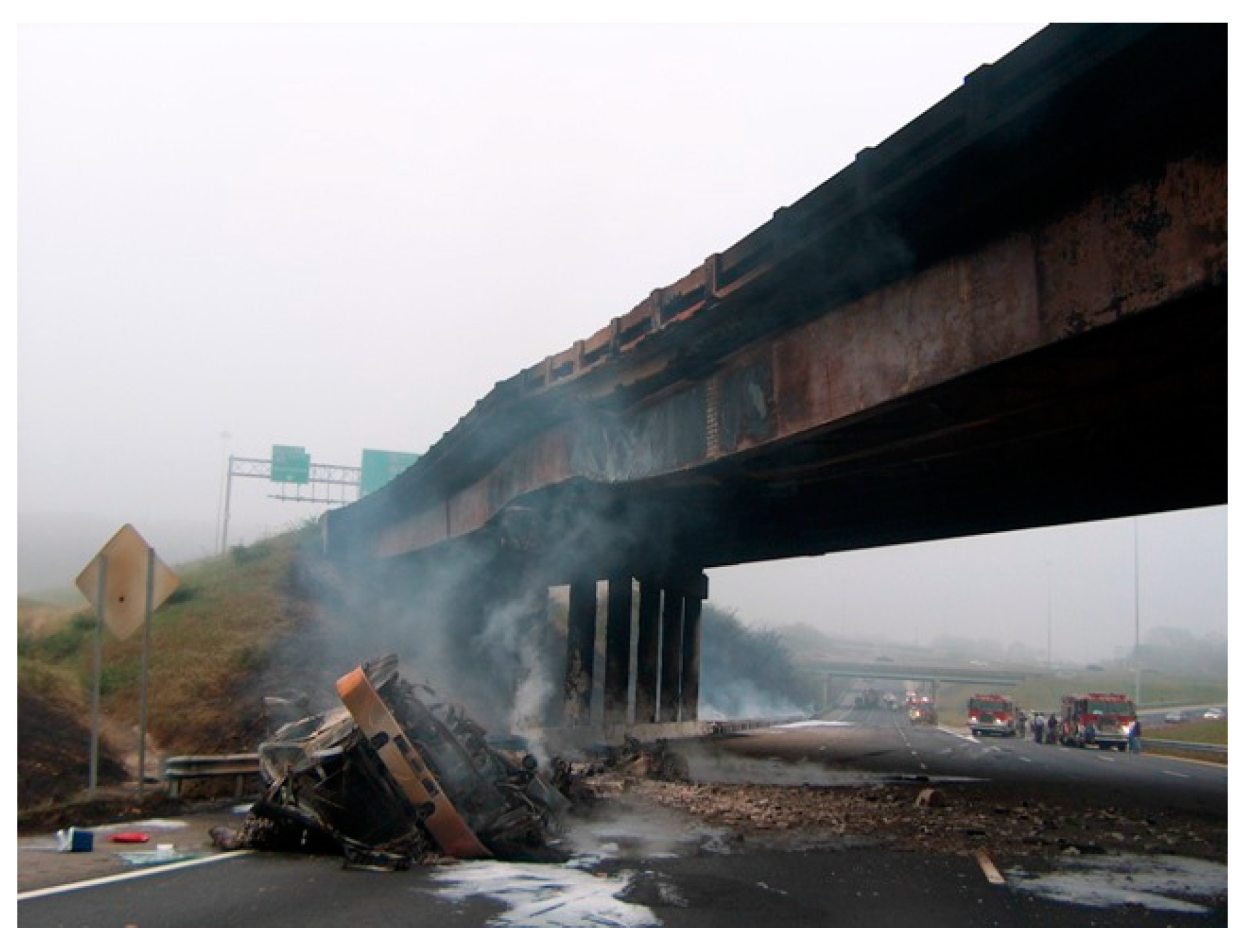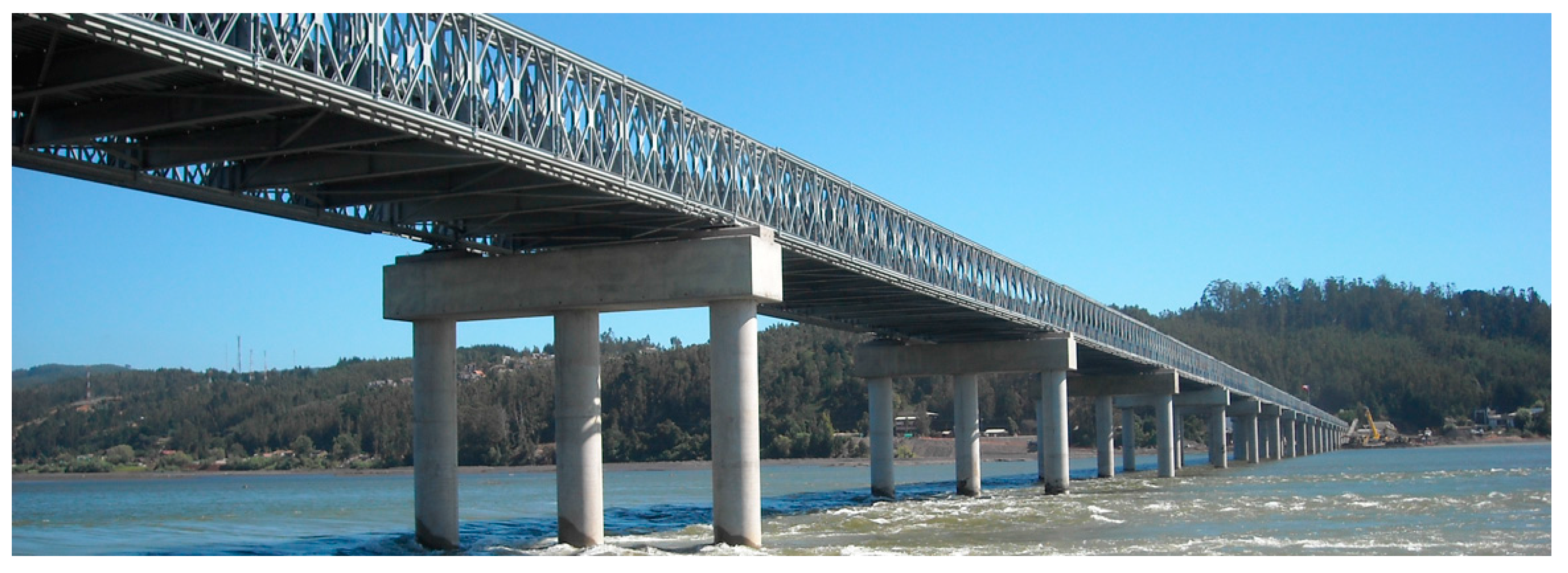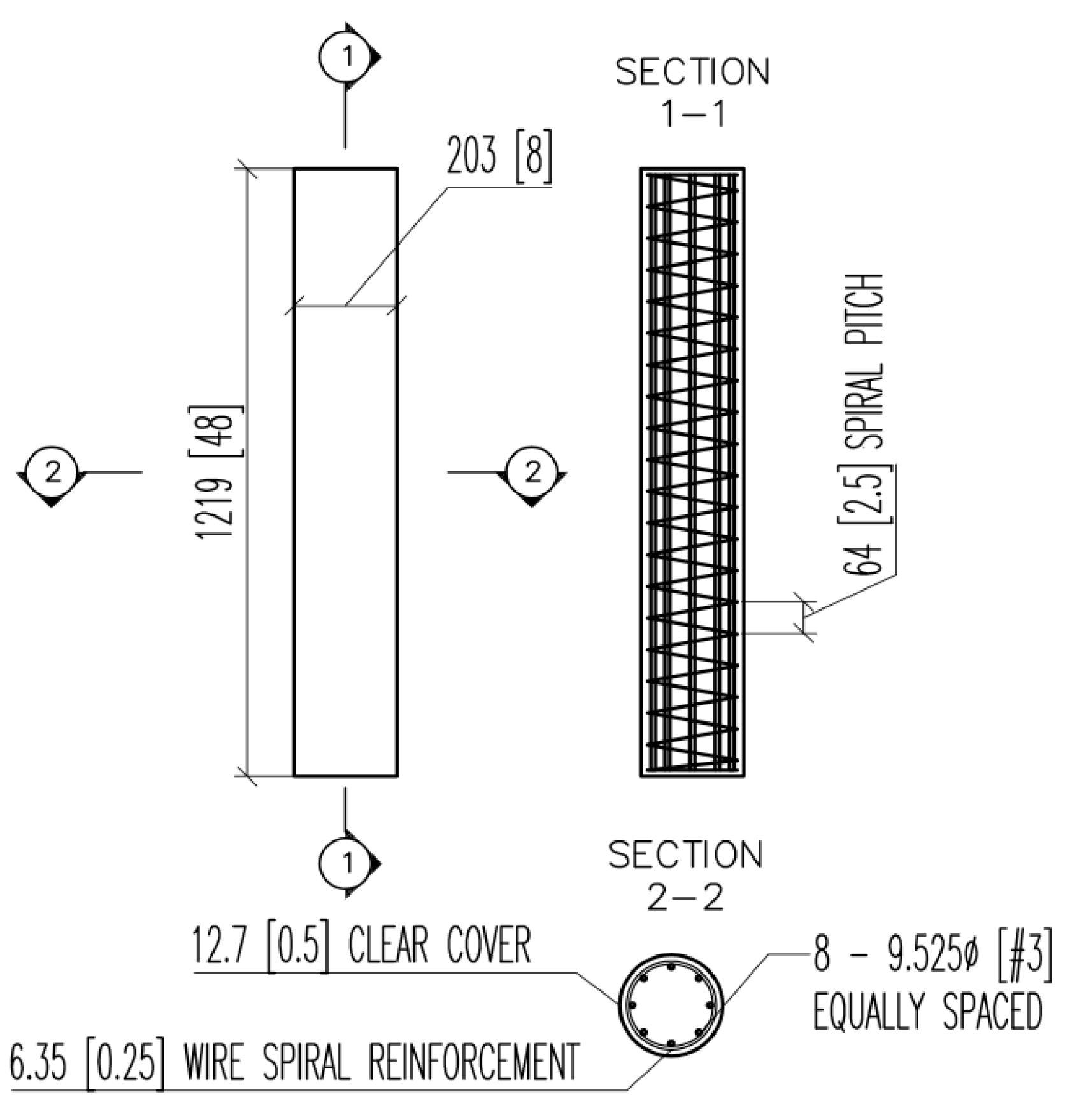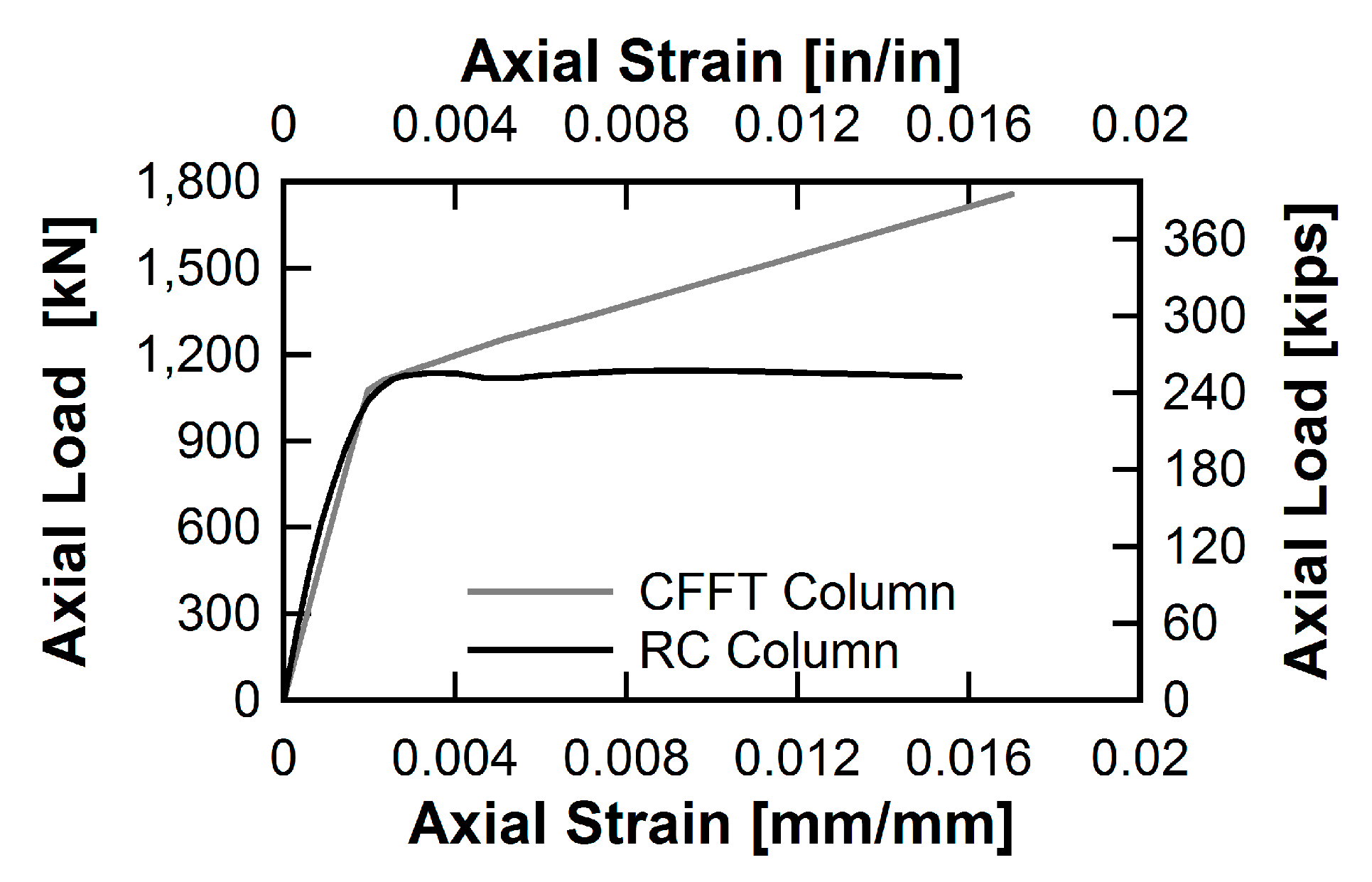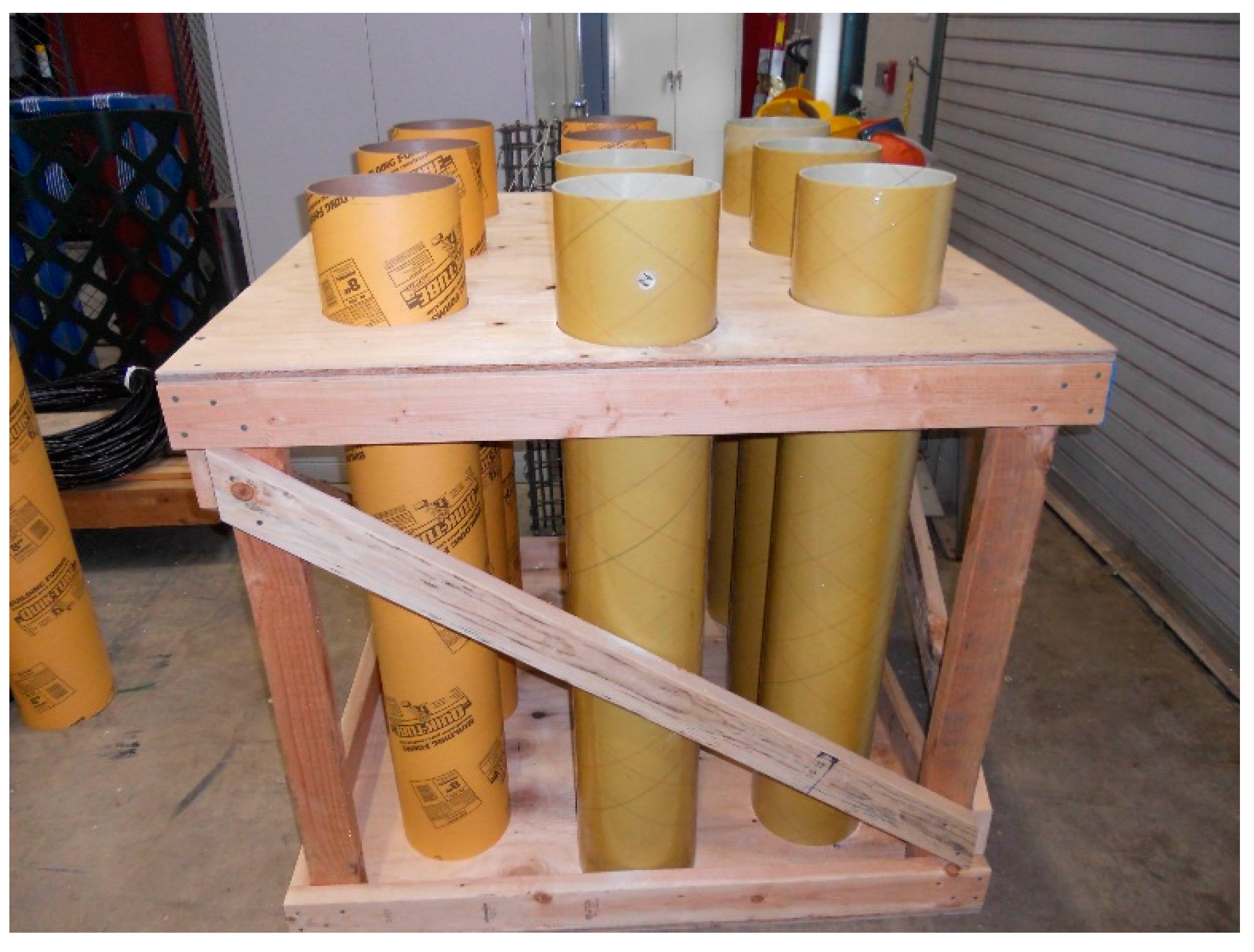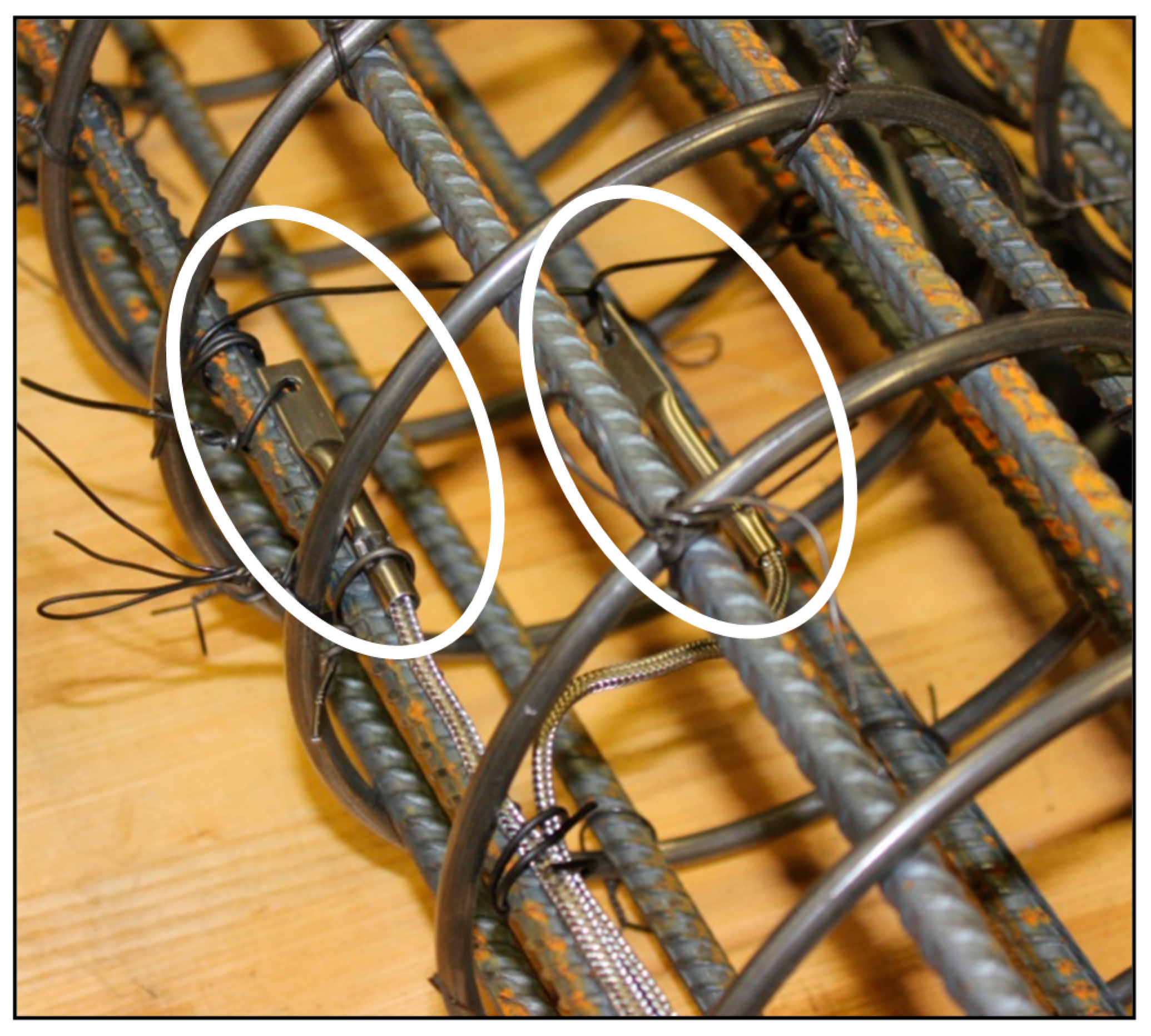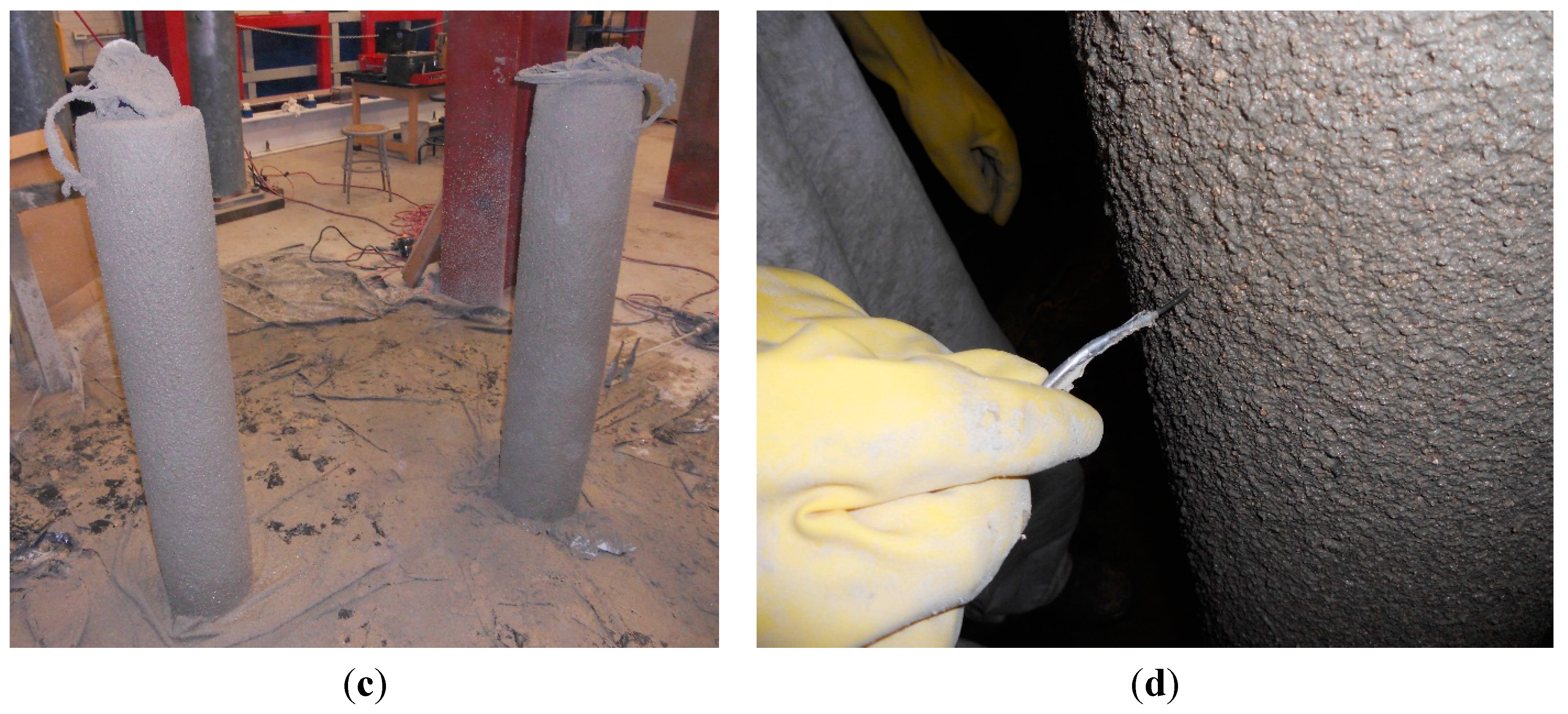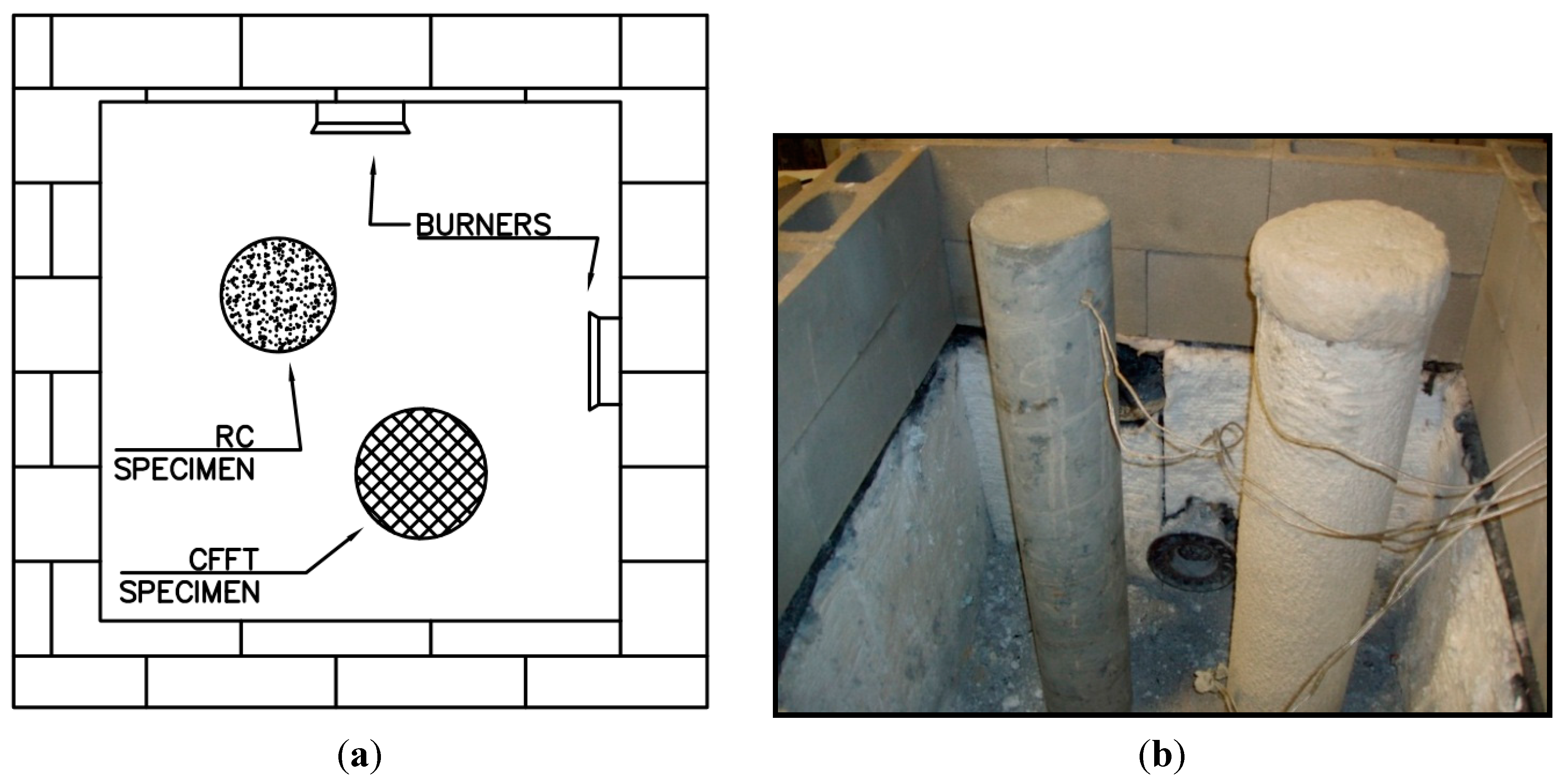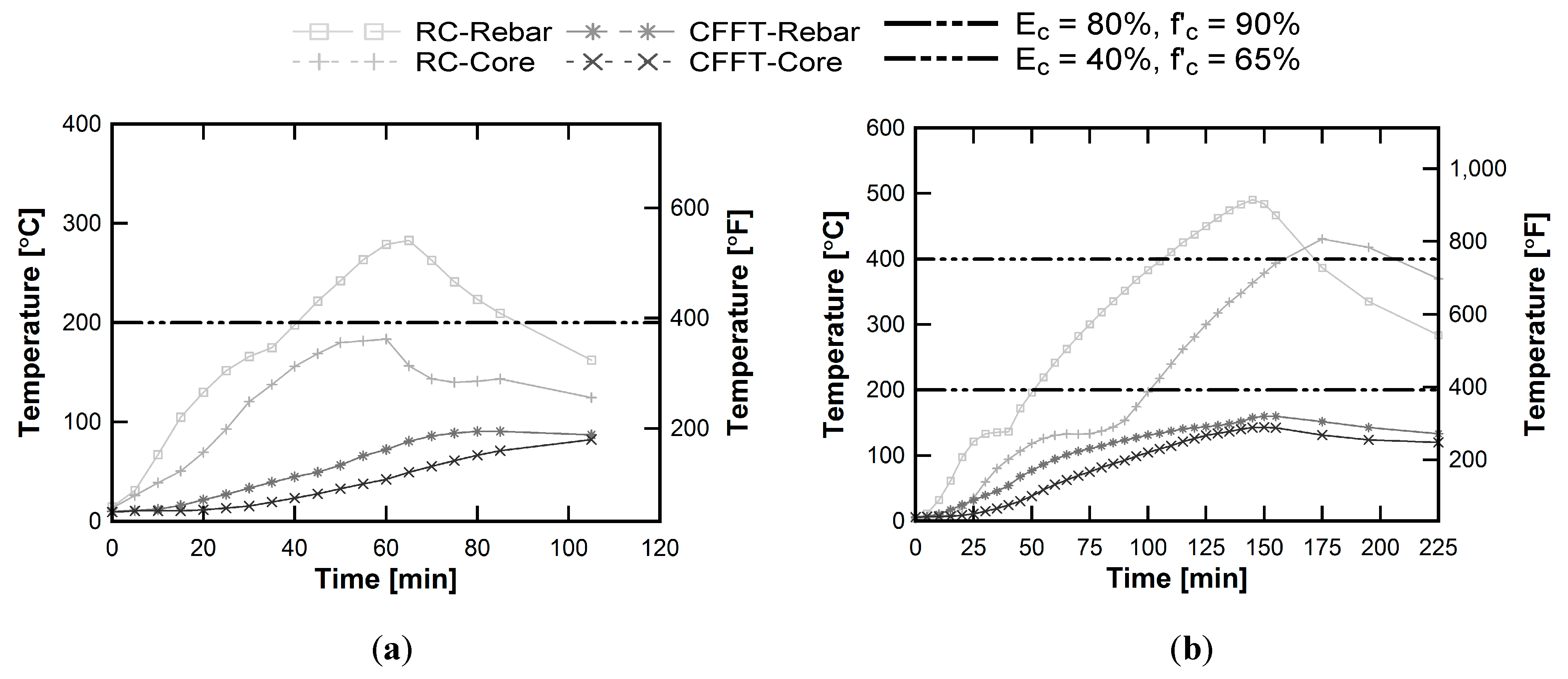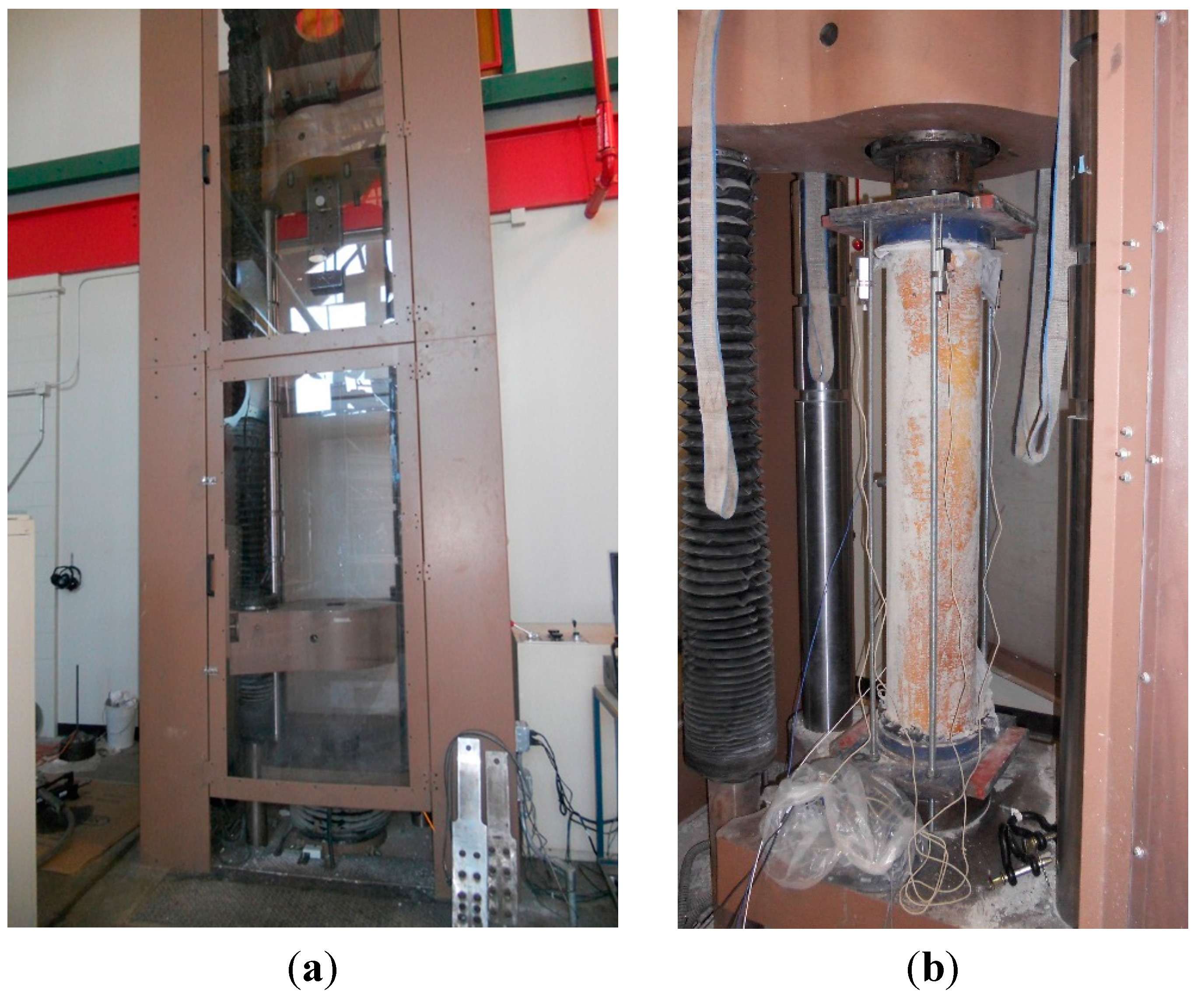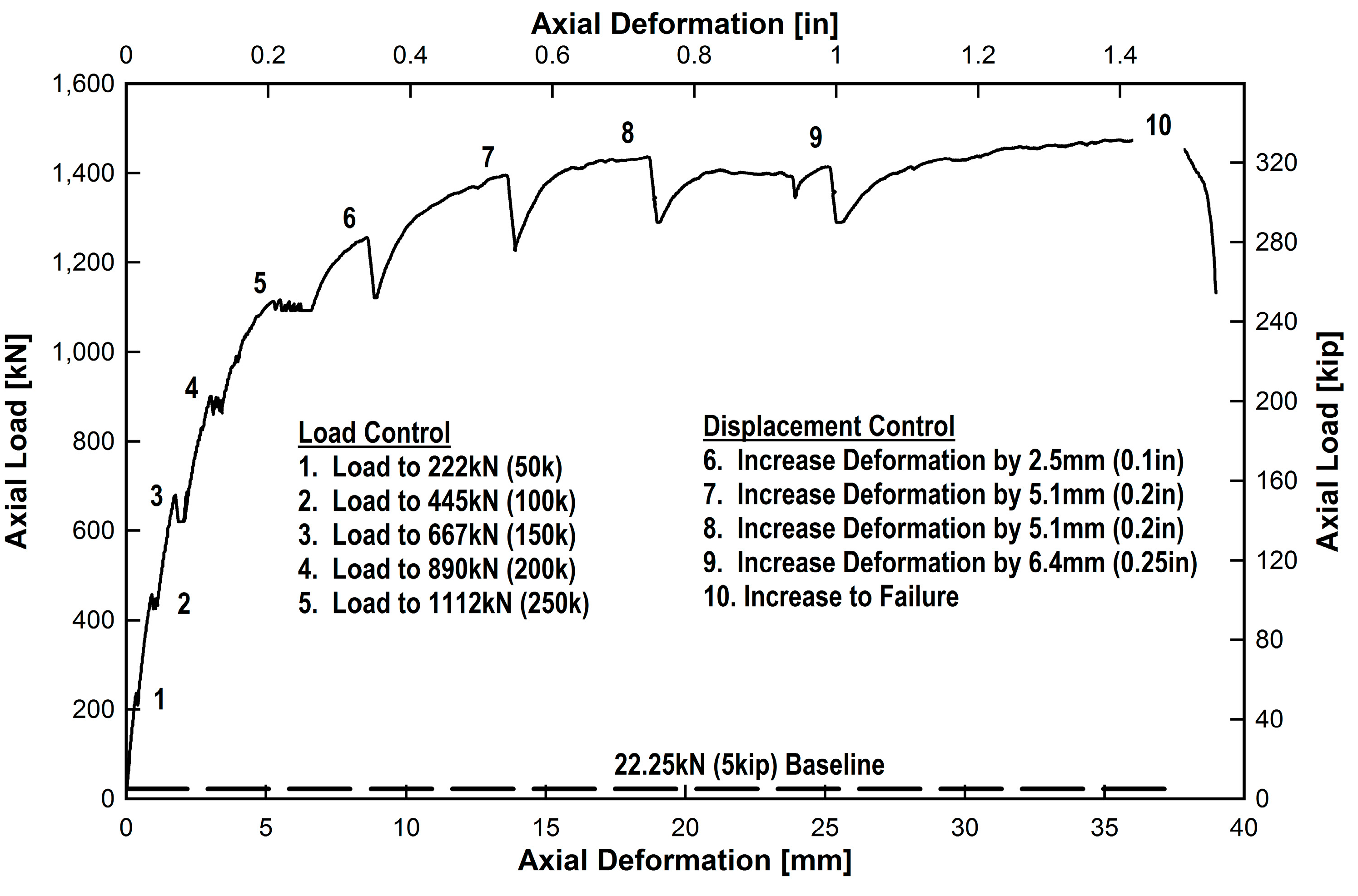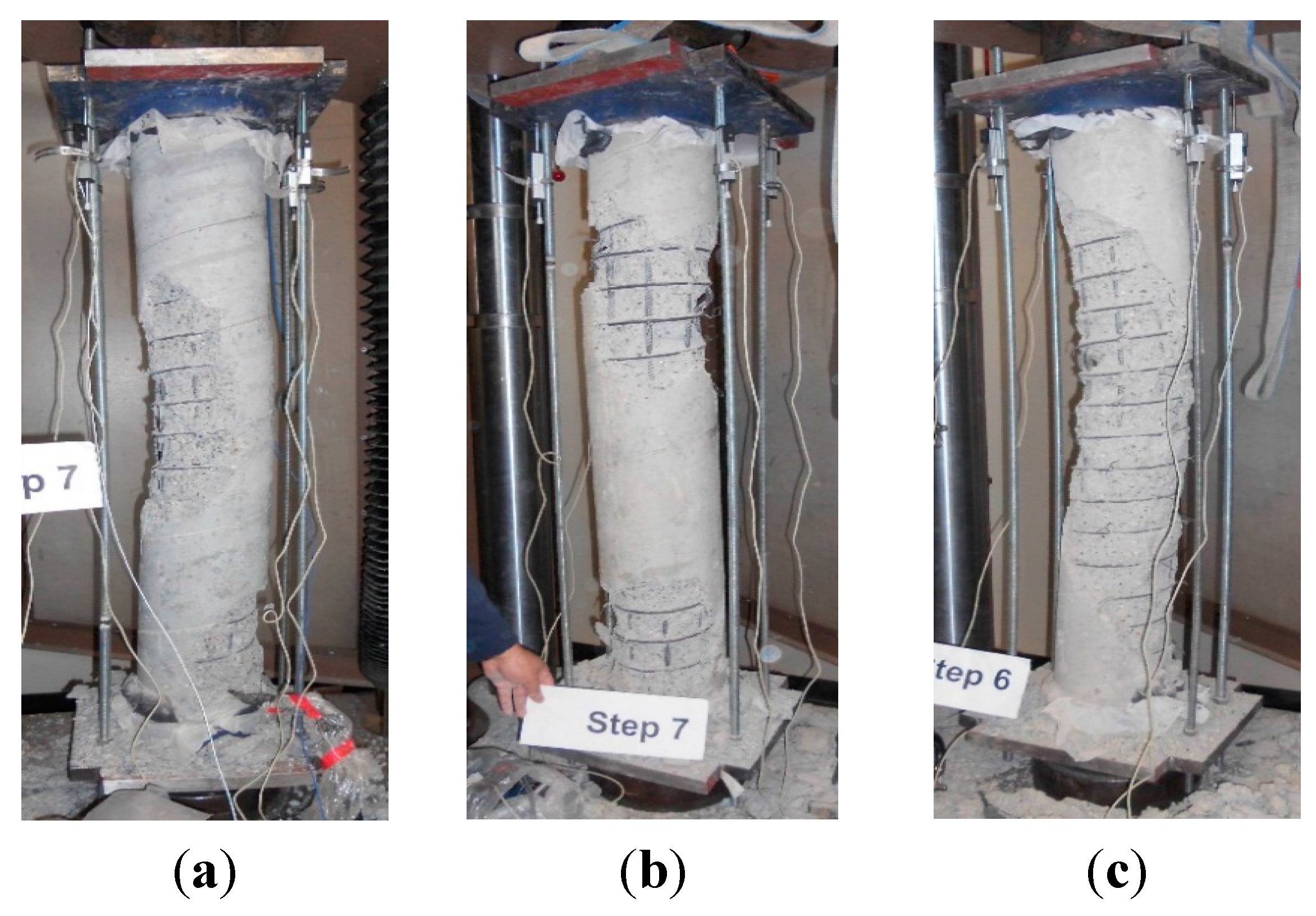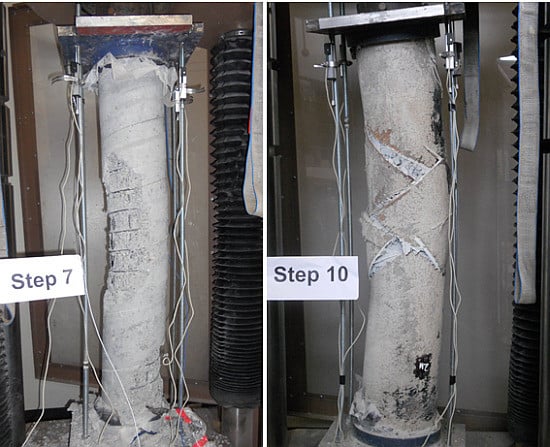1. Introduction
Between 1980 and 2012, 30 highway bridges failed due to fire hazard exposure in the United States (US). In the same time period, only 20 US bridges were reported to have failed due to earthquakes [
1]. Although hazards such as earthquakes, hurricanes, and floods can result in undeniably catastrophic life and monetary losses as evidenced by the numbers reported by Li
et al. [
2], fire is one of the most severe environmental hazards to built infrastructure causing more bridge failures over the last three decades than earthquakes. Despite this fact, there are no specific American Association of State Highway Transportation Officials (AASHTO) requirements for the protection of bridge elements against fire [
3]. Although AASHTO does not provide fire specifications for bridge elements, the National Fire Protection Association (NFPA) provides a standard for the protection of tunnels, bridges, and other limited access highways. Provision 6.3.2 of NFPA 502 explicitly states that critical structural members shall be protected from collisions and exposure to high-temperatures which can result in dangerous weakening or complete collapse of a bridge or elevated highway [
4]. This study compares the post-fire robustness of unprotected, conventionally constructed reinforced concrete (RC) bridge columns and protected, innovative concrete-filled fiber reinforced polymer (FRP) tube (CFFT) bridge columns.
According to the American Society of Civil Engineers (ASCE) Report Card on America’s Infrastructure [
5], one-fourth of the nation’s bridges are either structurally deficient or obsolete. Increased traffic demands combined with this deteriorated state of the nation’s bridges increases their vulnerability to many types of natural and manmade hazards including but not limited to earthquakes, corrosion, blasts, storm surge, and fires. Columns are critical elements of bridge infrastructure, and their proximity to hazardous materials transported on adjacent roadways or spanned waterways make bridge columns especially vulnerable to vehicle/vessel collisions and fire hazards. Most fire studies dedicated to bridge elements are focused on steel superstructures because the high thermal conductivity of steel material makes it inherently less fire resistant than concrete columns. However, the vulnerability of steel superstructures to fire should not overshadow the importance of the post-fire performance of substructure elements.
After extreme fire events, damage to bridge elements is often visually evident as shown in
Figure 1. In other instances, a fire event may cause structural degradation with minimal outward signs of damage. This is especially true for concrete components, which can be problematic for officials faced with the emergency decision to keep a bridge in-service or order a costly bridge closure after a fire event. Columns are critical for keeping a bridge open to regular traffic or emergency responders. Even if a bridge’s superstructure is significantly damaged, temporary structures, like the one shown in
Figure 2, may be rapidly installed to restore service if the columns are able to retain their capacity.
Figure 1.
Visible bridge damage due to vehicular fire.
Figure 1.
Visible bridge damage due to vehicular fire.
Figure 2.
Emergency bridge over Bio Bio River in Concepciόn, Chile.
Figure 2.
Emergency bridge over Bio Bio River in Concepciόn, Chile.
Many fire studies have been conducted on several different types of columns. However, most are focused on the performance of building columns. A series of studies conducted by Garlock and Quiel examines the performance of steel building columns subjected to fire. In one study, Garlock and Quiel [
6] use axial load and moment interaction curves to show that thermal gradients can have a significant effect on the yield capacity of beam-columns. In another, Quiel and Garlock [
7] use three different analytical models to determine the response of steel beam columns with thermal gradients. Agarwal and Varma [
7] completed a finite element and numerical analysis study of the importance of gravity columns to the overall stability of steel buildings. Han
et al. [
8] performed an experimental fire performance study of concrete-filled stainless steel tube columns directed toward off-shore structural applications. Kodur
et al., has conducted several studies on the effects of fiber reinforcement, fly ash, and tie configuration on the fire performance of high-strength concrete (HSC) columns [
9,
10,
11,
12]. There have also been a significant number of studies conducted on fiber reinforced polymer (FRP) confined concrete columns, including those conducted by Green
et al. [
13], Chowdury
et al. [
14], Cree
et al. [
15], Gefu
et al. [
16], Bisby
et al. [
17] and Kodur
et al. [
18] to name a few.
A fair amount of research has also been dedicated to the study of fire effects in bridges. Alos-Moya
et al. [
19] conducted a finite element (FE) and computational fluid dynamic (CFD) analysis of the Interstate 65 (I-65) overpass in Birmingham, Alabama that failed due to fire in 2002. The resulting numerical models were able to accurately replicate the performance and failure of the plate girder bridge. Garlock
et al. [
20] compiled a comprehensive review of fire hazards in bridges. The study reviewed major fire incidents, past case studies, and several assessment and repair methodologies. The review identified several literature gaps related to fire hazards and bridges. Performing experimental studies and determining post-fire strength were among the areas reported to be in need of further research in the findings.
The study presented herein aims to fulfill some of these research needs by experimentally quantifying and comparing the residual axial capacities of conventionally constructed RC and protected CFFT bridge columns after two distinct durations of fire exposure. The presented study stems from recent studies conducted on RC and CFFT bridge columns. Recent studies have proven the CFFT system a viable alternative to conventional RC columns for bridges vulnerable to earthquake and blast hazards [
21,
22,
23,
24,
25,
26,
27,
28]. Additionally, the CFFT system has shown that it can provide increased corrosion resistance and construction benefits including accelerated construction times and increased workzone safety [
26]. This study aims to extend the application of the CFFT system to instances where fire poses a threat to the performance of bridge columns.
For this study, two experimental fire exposure tests, resulting in material degradation but not complete failure, were conducted on four one-fifth scale bridge column specimens. Two of the column specimens were designed and constructed as conventional RC columns. The other two specimens were designed as CFFTs with similar dimensions and capacity to replicate those that would be used in comparable bridge designs. A fire resistant system was applied to the surface of each CFFT column to protect the FRP tube which is the main reinforcing mechanism for CFFTs.
The four one-fifth scale specimens were tested two at a time. First, one RC and one CFFT column were simultaneously exposed to more than two hours of extreme heat. Next, the other two specimens, one RC and one CFFT, were simultaneously exposed for one hour. Both durations of exposure caused the concrete temperatures in the RC columns to rise above typical limits for material degradation. However, neither RC column specimen exhibited outward signs of damage. Although the FRP tube did exhibit discoloration after exposure, the protection system applied to the CFFT columns kept the concrete temperatures below material degradation limits.
After the two fire experiments, the four fire-damaged columns were loaded axially to failure to obtain their post-fire axial performance characteristics. Residual axial capacity was chosen as the post-fire performance measure because bridge columns are primarily axial load carrying members. In addition to the fire-damaged specimens, two undamaged benchmark columns, one of each type, having the same design and constructed with the same materials as the fire exposed specimens were also tested axially to obtain the undamaged axial capacity characteristics of each column type. The residual axial capacity characteristics of the four fire exposed columns were compared to each other as well as to their respective undamaged benchmark specimens to quantify the post-fire performance of RC and CFFT bridge columns. While the fire damaged RC columns showed no outward signs of damage, both specimens exhibited losses in axial strength and stiffness. Conversely, the protected CFFT columns saw slight gains in capacity after both durations of fire, and exhibited less stiffness degradation than their RC counterparts.
3. Results and Observations
3.1. General Observations
Upon removal from the furnace, none of the columns showed any significant outward signs of material degradation. The most noticeable signs of damage included discoloration of the FRP tube of the CFFT column after the 2-Hr test as shown in
Figure 10b, and a change in the sound properties of the RC columns after both the 1- and 2-Hr durations. After the RC columns were removed from the furnace, a sound similar to that of a ceramic material was emitted when the surfaces of the columns were tapped rather than the typical sound expected when tapping a concrete column.
Figure 10.
(a) Undamaged CFFT column and (b) discolored fire damaged CFFT column.
Figure 10.
(a) Undamaged CFFT column and (b) discolored fire damaged CFFT column.
3.2. Furnace Temperature Data
Furnace temperatures were recorded every five minutes throughout the duration of both tests, and the recorded temperature time histories are shown in
Figure 11. Although the furnace burners were able to closely match the steep initial temperature increase rate of the ASTM E119 curve, the average furnace temperatures were about 200 °C below the ASTM curve for the majority of each test. The peak average furnace temperatures recorded were 696 °C and 786 °C for the 1-Hr and 2-Hr tests, respectively.
Because the furnace temperatures did not meet the ASTM standard, the 2-Hr test was extended by an additional 20 min. By prolonging the 2-Hr test, the total amount of temperature exposure, defined herein as the area beneath the temperature curve, was nearly 96,000 °C-min. This value falls within 10% of the total amount of temperature exposure for two hours following the ASTM E119 curve, or 105,000 °C-min. To maintain the differentiable levels of damage between the two tests, the furnace burners were extinguished at exactly 60 min for the 1-Hr test.
Figure 11.
Furnace temperatures for (a) 1-Hr and (b) 2-Hr tests shown with the American Society for Testing and Materials (ASTM) E119 curve.
Figure 11.
Furnace temperatures for (a) 1-Hr and (b) 2-Hr tests shown with the American Society for Testing and Materials (ASTM) E119 curve.
3.3. Concrete Temperature Data
Although the columns showed minimal evidence of structural damage, the temperatures of the interior concrete recorded during testing, shown in
Figure 12a,b, indicated that there would be a reduction in both strength and stiffness of the RC columns. Chang
et al. [
37] established a database of concrete mechanical properties after being heated to temperatures as high as 800 °C. The study showed that concrete compressive strength is reduced by 10% at a temperature of 200 °C and by 35% at 400 °C. Similarly, the elastic modulus of concrete is reduced by 20% at 200 °C and by 60% at 400 °C. During the 1-Hr test, the concrete temperature at the level of the rebar reinforcement of the RC column reached 283 °C, exceeding the 200 °C threshold. During the 2-Hr test, the concrete of the RC column reached 431 °C at the core and 491 °C at the level of the rebar. Both temperatures exceed the 400 °C threshold, indicating significant losses in strength and stiffness of the entire cross section.
Figure 12.
Interior concrete temperatures during the (a) 1-Hr and (b) 2-Hr tests.
Figure 12.
Interior concrete temperatures during the (a) 1-Hr and (b) 2-Hr tests.
In comparison, the maximum concrete temperature recorded at the level of the rebar of the CFFT column during the 1-Hr test was 91 °C. For the longer duration tests, the peak concrete temperature of the CFFT column was 160 °C at the level of the rebar. Because the fire protection system was able to keep concrete temperatures of the CFFT columns below 200 °C during both test durations, no significant losses in strength or stiffness were expected in the following residual axial capacity tests.
3.4. Residual Capacity Tests
Upon completion of the fire tests, the four damaged columns were returned to the UConn Structures Laboratory for axial capacity testing. Because bridge columns are primarily axial load carrying members, the residual axial load carrying characteristics were chosen as measures of post-fire robustness for the RC and CFFT columns. The four fire damaged columns (RC 1-Hr, RC 2-Hr, CFFT 1-Hr, and CFFT 2-Hr) as well as two undamaged benchmark columns, one of each type, were loaded axially to failure using a 1779 kN (400 kip) Satec load frame controlled by an MTS FlexTest 40 controller. The empty load frame is shown in
Figure 13a.
Figure 13.
(a) Empty 400 kip load frame; and (b) CFFT 1-Hr axial load test setup.
Figure 13.
(a) Empty 400 kip load frame; and (b) CFFT 1-Hr axial load test setup.
Prior to testing, the column specimens were capped using steel plates and a high-strength epoxy to ensure uniform distribution of the axial load on the entire column cross section. To minimize potential P-delta effects, lubricated spherical bearings were used on either end of the column, and measurements were taken to ensure each column was aligned vertically with the load frame. A maximum of eccentricity of 6.35mm (¼ in.) was anticipated which would result in minimal unintended flexural loads.
The 10-step loading protocol shown in
Figure 14 was used to determine the axial load carry characteristics of the fire damaged and benchmark columns. The load was increased by 222 kN (50 kip) for the first five steps. Starting with step 6, displacement control was used to capture the softening effects of each column. Between each step, the columns were unloaded to a baseline load of 22.25 kN (5 kip) to capture unloading and reloading characteristics. The axial loads were captured directly from the controller, and the axial deformations of the columns were measured using four 50 mm (2 in.) Humboldt potentiometers.
Figure 13b shows the complete load frame and potentiometer test setup of the CFFT 1-Hr column.
Figure 14.
Loading protocol for axial capacity tests.
Figure 14.
Loading protocol for axial capacity tests.
3.5. Residual Axial Strength
The load-deformation curves obtained from the six axial capacity tests are displayed in
Figure 15, and a summary of the results can be found in
Table 3. Strength measurements were taken at two locations along the curves. First, the maximum capacity was recorded. Next, the axial capacity at an axial deformation, δ
P, equal to 10 mm was recorded. This measurement was selected because the RC-Benchmark column first exhibits a loss in strength at δ
P = 10 mm. The maximum axial capacities of the RC columns were reduced by 3.3% and 23.8% after one and two hours of exposure, respectively. At δ
P = 10 mm, the residual axial capacities of the RC columns were compromised by 14.1% and 26.7% for the same respective test durations.
In contrast, the CFFT columns showed no significant loss in maximum capacity. The CFFT-1-Hr column had a negligible maximum capacity loss of 2.6%. The CFFT-2-Hr column actually exhibited a 7.3% increase in maximum capacity. The fire protection system applied to the surface of the CFFT columns allowed the concrete temperatures to elevate but not exceed 200 °C. In addition, the FRP tube slowed evaporation of the column’s moisture content creating an environment similar to steam curing and causing a slight increase in maximum capacity. Negligible axial capacity losses of 2.7% and 5.2% were also recorded for the CFFT columns at δP = 10 mm after one and two hours of exposure, respectively.
Figure 15.
Load-deformation relationships of RC and CFFT fire damaged columns.
Figure 15.
Load-deformation relationships of RC and CFFT fire damaged columns.
Table 3.
Summary of test capacity results of fire damaged specimens.
Table 3.
Summary of test capacity results of fire damaged specimens.
| Axial Capacity Parameter | RC Columns | CFFT Columns |
|---|
| Benchmark | 1-Hr Exposure | 2-Hr Exposure | Benchmark | 1-Hr Exposure | 2-Hr Exposure |
|---|
| Maximum Capacity, kN (kip) | 1,094 (246) | 1,058 (238) | 834 (187) | 1,467 (330) | 1,429 (321) | 1,574 (354) |
| Capacity at δP = 10 mm, kN (kip) | 1,075 (242) | 909 (204) | 789 (177) | 1,276 (287) | 1,242 (279) | 1,210 (272) |
| Axial Ductility | 4.90 | 4.27 | 6.44 | 15.9 | 11.9 | 13.5 |
| Axial Stiffness, kN/mm (kip/in.) | 423 (2413) | 246 (1406) | 142 (808) | 416 (2377) | 443 (2529) | 310 (1772) |
3.6. Axial Ductility and Residual Axial Stiffness
Ductility is traditionally defined as the ratio of ultimate displacement over yield displacement. However, the definitions of ultimate displacement and yield displacement are not always easily defined for reinforced concrete structures. In this study, the axial yield displacement is defined as the displacement corresponding to an average axial strain of 0.002, marked by the yield line in
Figure 15, and the ultimate displacement is defined as the displacement at which the axial load drops to 85% of the maximum.
The RC columns not only exhibited losses in axial capacity, but also in initial axial stiffness. The initial axial stiffness of each specimen was measured as a secant stiffness between the origin and the point at which the axial strain value is 0.002. After the 1-Hr test, the RC column had lost 41.7% of its initial axial stiffness. For the same duration, the CFFT column did not show any initial axial stiffness loss. For the longer test, the CFFT column did show a 25.5% loss in initial axial stiffness. However, the RC column exhibited a significantly greater loss of 66.5% after the 2-Hr test.
3.7. Failure Modes
Figure 16 displays the failure modes of the RC-benchmark, 1-Hr, and 2-Hr columns under the incremental axial load. The failure mode of the RC-benchmark column was identified as concrete crushing at midspan which is the typical failure mode for a RC column under pure axial compression. The degradation of the compressive strength of the concrete material is seen in the failure mode of the fire-exposed RC columns. The degraded cover material spalled prematurely, ultimately resulting in the reduced axial capacity of the fire-damaged columns. The columns deformed axially until step 6 of the loading protocol when the loss of the cover concrete became non-uniform.
Figure 16.
Failure modes of RC-benchmark (a); 1-Hr (b); and 2-Hr (c) exposure columns.
Figure 16.
Failure modes of RC-benchmark (a); 1-Hr (b); and 2-Hr (c) exposure columns.
Similar photos of the axial failure modes of the CFFT columns are shown in
Figure 17. Because, the fire protection system was able to keep the FRP and concrete temperatures low, the fire-exposed CFFTs exhibit the same failure mode that is seen in the CFFT-benchmark column. Although the photos look as though the columns had significant bending stresses, the cap rotations measured by the potentiometers showed negligible rotation of the steel caps until step 10 when the FRP tubes ruptured at midspan.
Figure 17.
Failure modes of CFFT-benchmark (a); 1-Hr (b); and 2-Hr (c) columns.
Figure 17.
Failure modes of CFFT-benchmark (a); 1-Hr (b); and 2-Hr (c) columns.
4. Conclusions
The following observations and conclusions highlight the findings of this study:
Degradation of the concrete material of RC columns can occur during exposure to extreme temperatures without showing significant outward signs of damage. The most noticeable sign of material degradation after the conducted experiments was a change in the sound properties heard when the RC column surfaces were tapped.
The loss of compressive strength and decrease in elastic modulus of the concrete results in reduced axial capacity and initial axial stiffness of RC bridge columns exposed to fire.
The RC columns exhibited losses of 15.4% and 26.6% in axial capacity and 41.8% and 66.4% in initial axial stiffness after one hour and two hours of exposure to extreme temperature, respectively.
Although the 2-Hr CFFT column exhibited discoloration of the FRP tube, the Tyfo® CFP system provided sufficient fire protection to the CFFT columns allowing them to maintain their axial load carrying capabilities after more than two hours of extreme temperature exposure.
No meaningful loss in axial capacity was observed in the CFFT columns after the 1-Hr or 2-Hr tests. There was also no loss initial axial stiffness after one hour, and just a 25.5% loss in initial axial stiffness after more than two hours of exposure to extreme temperature.
The significant loss of axial strength and stiffness observed in the fire damaged RC columns resulted in larger values of axial ductility when compared to the undamaged column.
